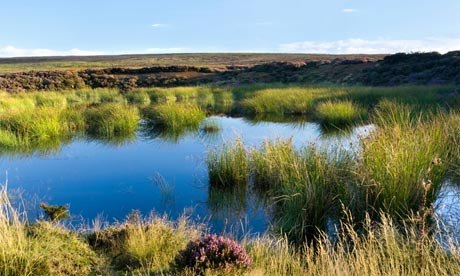
A peat bog on Westerdale Moor in the North Yorkshire Moors National Park. You can help protect such environments by using peat-free compost. Photograph: Alamy
Amateur gardeners take note: your choice of compost could be contributing to climate change. Why? It's all to do with peat.
Prior to the 1970s, most gardeners relied on loam-based potting mixes for growing plants. But they were heavy and expensive to transport and far from ideal. Then lightweight peat-based products began to be aggressively marketed as a cheaper alternative, and gardeners embraced them wholeheartedly.
As famous gardener Christopher Lloyd wrote in his 1970 book The Well-Tempered Garden: "There is currently a tremendous vogue for peat, which is so widely believed to be a panacea for every cultural problem that supplies can barely keep pace with demand."
Lloyd put his finger on a fact that may escape many modern gardeners - peat has only been a horticultural must-have for the past 40 years or so.
When Fisons launched a brand new invention called the Gro-Bag in 1973, filled of course with a peat-based compost mix, this black crumbly stuff became so common as a growing medium that many gardeners hardly realised what their compost sacks were full of.
But what is peat, and why did it become so popular? Peat is made of semi-decomposed plant debris that's formed at a snail's pace over hundreds or thousands of years in layers of about 1mm a year in the waterlogged, oxygen-starved conditions found in bogs both in the UK and around the world. Once extracted, this rich, dark stuff holds both water, air and plant nutrients well, meaning it's been seen as highly useful in the garden as a mulch, a soil improver, and most crucially as a growing medium.
But during the last two decades, we've woken up to the fact that the bogs being destroyed to feed our peat addiction are valuable habitats for all kinds of increasingly rare plants and animals, and need protection.
And in the last few years, the role of peat extraction in hastening climate change has hit home, too. Scientists recognised that peat bogs act as huge 'carbon sponges': as peat is formed it locks away the carbon dioxide that is absorbed by plants as they grow. When the peat is extracted, that CO2 - a potent greenhouse gas - is released back into the atmosphere. Digging up peat from British bogs for use in our gardens releases nearly half a million tonnes of carbon dioxide a year – the equivalent of carbon emissions for around 100,000 UK households.
Amateur gardeners make up around two thirds of the peat market, so it's vital that we wean ourselves off our peat habit. And the message is starting to get through to both growers and producers: peat's use in the garden dropped for the first time in 2007, (from 3.4m cubic metres to 3.01m cubic metres), and in the same year the proportion of peat in compost mixes used by amateur gardeners dropped to 72%, down from 94% in 1999.
The government set a target for compost to be 90% peat-free by 2010, but as more and more of us latch onto the delights of growing our own food movement, we're also heading to the garden centre to buy compost in increasing numbers. That means it is even more vital that alternatives to peat take centre stage in potting sheds and greenhouses across the land, as gardeners switch to peat-reduced products - or even better, peat-free compost wherever they can. Click here to check out the options.




No comments:
Post a Comment